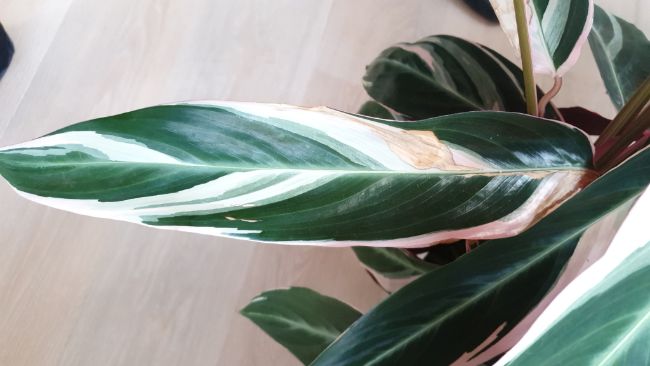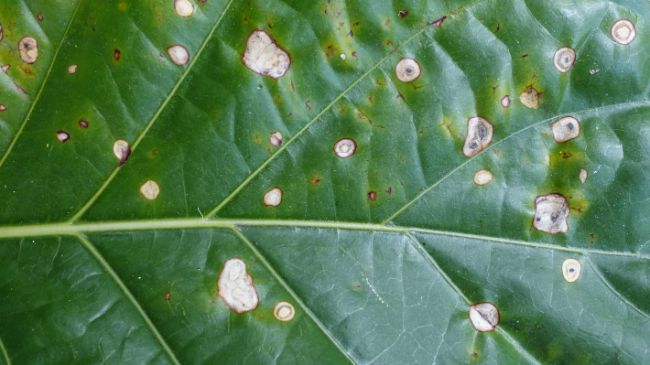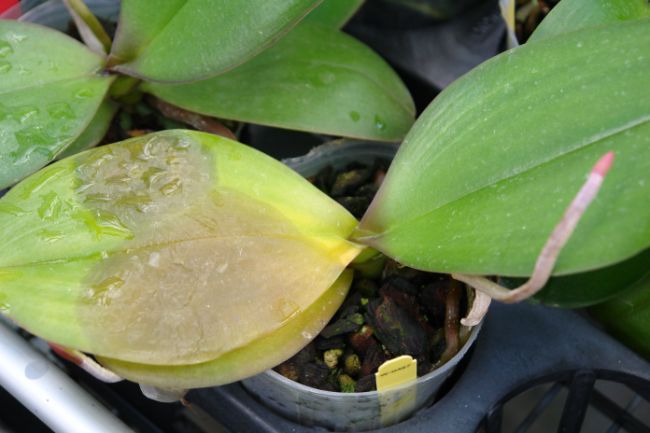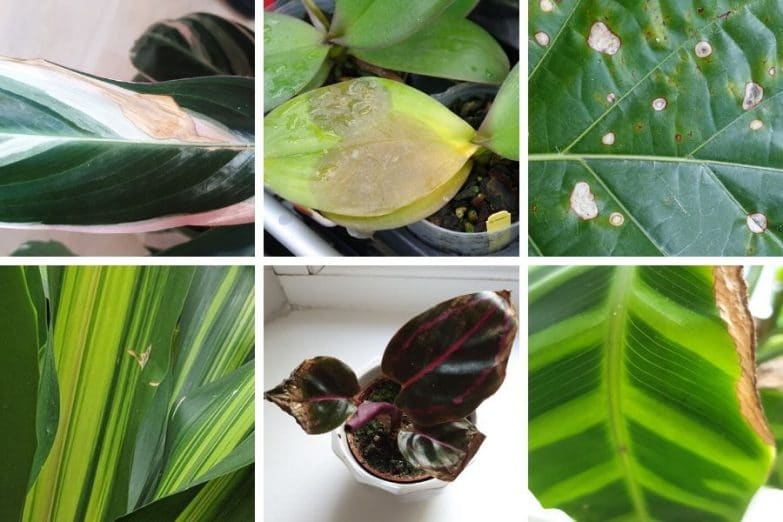Have you noticed brown spots on the leaves of your houseplants? Maybe you have unsightly brown spots or areas and are wondering what is wrong. Brown spots on houseplant leaves happen for a number of reasons, most of which are preventable and even correctible. In this article, I’ll discuss the most common reasons houseplant leaves get brown spots, and how you can fix them.
What Causes Brown Spots On Houseplant Leaves?
There are 6 common problems that can cause brown spots on houseplant leaves. They are:
- Excess light/scorching
- Low humidity
- Pests
- Leaf spot diseases
- Watering problems
- Fertilizer problems
Let’s look at each cause, in turn, to help you identify the problem, and help you fix your plant.
Excess Light/Scorching
Houseplants are often tropical plants, with origins growing in the shade of the forest understorey. This makes them well suited to the lower light levels found inside your home. However, too much light – whether it is natural or artificial light – can cause your plants to burn or scorch.
Symptoms of burning or scorching in houseplants will show up as brownish, burnt spots on the leaves, brown tips on the leaves, or even pale, yellowed leaves. In more severe cases, you will see a combination of all three. If you see these symptoms on your plant, first examine the location of the plant in relation to its light source.
Is the plant receiving direct sunlight through a window or direct light from an artificial light source? If it is too close to either direct sunlight or artificial light, the leaves may burn, causing brown leaf tips and brown spots on the leaves.
Try moving the plant a little further from the window to reduce the light intensity. Alternatively, you can move the plant out of direct sunlight, so it is only getting bright, indirect light, which will be more suitable for many houseplants.
Scorching can also occur when light intensity changes with the seasons. A plant that was happy over the winter in a south-facing window may need to be moved further away from the window, or to a different location in the summer, as light intensity increases.
You can safely prune these off if only a few leaves are affected. If the plant is badly affected, you are best waiting for some healthy new growth before pruning the damaged leaves. If just the tips are scorched, you can remove them with a clean, sharp pair of scissors. Try to mimic the natural shape of the plant’s leaves when doing so.
Scorch damage cannot be undone, but hopefully, with quick action, the plant will grow new, healthy leaves and the old leaves can then be removed to make your plant look healthy again.

Low Humidity
If your plant develops crispy brown leaf tips you may need to assess the humidity levels in your home and especially, around your plant. You may also see leaves dropping and flower buds falling off. If this is the case, and the culprit is not too much light, it might be too little humidity.
Calatheas, for example, will quickly experience brown spots or leaf tips if humidity levels are too low. It is common for the humidity in homes to become much lower during the colder winter months because cooler air holds less humidity and central heating will dry out the air, as well.
Getting a digital hygrometer is a great idea if you are strugggling to keep your houseplants looking well. This will tell you t a glance how humid your home is, and you can adjust the humidity levels as required.
If the humidity in your home is too low for your plant, you can raise the humidity around the plant by placing it on a pebble tray. Fill a dish with pebbles and pour water over the pebbles so that the water doesn’t quite reach the top of the pebbles. Set the plant pot on top of the pebbles, but so that it doesn’t sit in the water. This will help raise the humidity directly around your plant.
You can also group plants closely together to raise humidity levels around your plants, or read about some other methods in my article about humidity for houseplants.
Once the plant is on its way to recovery, you can use sharp, clean scissors to remove just the browned tips. If any leaves are more than 2/3 brown, you may want to remove the entire leaf.
Pests
Little brown speckles on the leaves of your plant can be an indication of a common houseplant pest – spider mites. You may also see mottled leaves and fine webbing on the underside of the leaves, which also indicate the presence of spider mites.
The easiest and least expensive means of controlling spider mites is to simply wash them off with room temperature water. Wash infected plants once per week, being sure to rub off any webbing that you see.
Keep the humidity high around your plant in between washings as this will discourage the spider mites from spreading. If washing the plant regularly doesn’t work to control the spider mites, read my article about getting rid of spider mites, for other solutions.
Other sap-sucking pests can cause brown spots on houseplant leaves. Mealybugs, aphids, thrips, and scale are the other common culprits. All these bugs feed by sucking the sap from the leaves and stems of your houseplants, damaging a small area around where they feed, causing brown or yellow spots on the leaves.
It’s always good practice to check your houseplants regularly for any sign of pests and immediately quarantine your plant if you suspect an infestation. Read my article about common houseplant pests to learn everything you need to know about identifying, treating, and preventing these bugs.
Leaf Spot Diseases

Rust
Rust normally presents with multiple brown spots on your plant’s leaves and brown rings underneath the leaves. It is a fungus that thrives in wet environments, and the brown spots on the leaves are actually collections of spores. Diagnosis is easy, as the spots can be partially rubbed off with a cloth. Just wipe a spot and see if the color transfers to the material to see if you have a rust problem.
To treat rust, first, cut off the affected leaves, tie them in a plastic bag, and put them in the trash. Next, treat the plant with a sulfur-based fungicide. Read more about treating and preventing rust on your houseplants here.
Bacterial Leaf Spot
If you see sunken, wet-looking brown spots on the leaves of your plant, you may have a problem with bacterial leaf spot. Bacterial leaf spots are common in plants that are overwatered, or kept in excessively humid or poorly ventilated areas.
Bacterial leaf spots can be a serious problem. Removing affected leaves and stems may treat a mild infection, but more widespread disease often spells the end for your plant. Make sure to isolate your plant to prevent spread of the disease to your other houseplants.
Anthracnose
Anthracnose is a group of fungal diseases that causes dark, sunken lesions on leaves and stems. You can identify it by looking for multiple small, irregular yellow or brown spots on the leaves that slowly enlarge over time.
It is not normally fatal for houseplants, but it can spread easily and ruin the appearance of your plants. The solution is to quarantine any affected plants, remove all affected foliage, and treat the plant with a copper-based fungicide.
Root And Stem Rot
If the stem and roots of your plant turn brown or black and feel mushy and soft, you may have an issue with root rot and stem rot. Rot is typically caused by overwatering and poorly draining soil. Remove affected roots and replant the affected plant into fresh soil. Make sure your pot has good drainage holes and always empty the catch tray after you have watered your plant. Following these steps might able to save the plant.
Fungal Leaf Spots
Small brown spots with yellow edges may indicate a problem with fungal leaf spots. Remove the infected leaves and destroy them, then treat the plant with neem oil according to the bottle’s directions. If the neem oil does not prevent further infection, you may need to destroy the entire plant.
Read my article on common houseplant diseases to learn more. I cover how to identify, fix and prevent the most common diseases that can affect your houseplants.
Watering Problems
Brown leaf tips or brown dying leaves can be a sign of underwatering, especially if your plant is also drooping. Check to see if the soil is completely dry. If it is, underwatering might just be your problem.
Start by giving your plant a long, thorough drink of water. Make sure to empty the drip tray once the pot has drained completely so that your plant does not sit in soggy soil. Your plant should perk up within a few hours.
To prevent the problem from happening again, make sure you understand the watering needs of your plant. Some plants need moist but not soggy soil while other plants need the soil to dry out completely in between waterings.
In the winter, even indoor houseplants will go dormant, much like outdoor plants, and they will require less water. However, when the spring comes and the number of daylight hours increase, your plants will increase their need for water. Sometimes it is the change of seasons that brings on watering issues due to the change in water needs.

Fertilizer Problems
If you see brown leaf tips on your plants, the problem could be a build-up of too much fertilizer salts. If this is the case, first you will want to remove any crusty build-up that appears on the top of the soil. Then you will need to flush the soil thoroughly to wash out the excess salts. You may want to do this at your sink to prevent water from running all over the place.
Allow water to run through the soil for several minutes. After you have rinsed the soil completely, allow all of the excess water to drain out. Do not water again until the surface of the soil has dried out. If the build-up of salts is severe, you may need to completely repot the plant into fresh soil. You may want to flush your plant’s soil monthly to prevent a build-up of salts in the soil.
To prevent fertilizer problems, err on the side of caution when fertilizing your houseplants. Most houseplants need less fertilizer than you think. Find out about your plant’s fertilizer needs and apply cautiously. Read my guide to fertilizing houseplants to learn more.
Troubleshooting Brown Spots On Houseplant Leaves
Sometimes it can be difficult to figure out exactly what the problem is with your plant. If you have followed all of the steps and still cannot identify the cause of brown spots on your plants, take a little time to observe your plant and review its care requirements to ensure you are providing the correct conditions.
I recommend doing the following until you know what the problem is:
- Remove the damaged leaves or foliage.
- Clean and sanitize all plant tools between using them on plants so you do not spread the problem.
- Water the plant only when the soil becomes dry and do not water the foliage.
- Observe your plant closely to try to identify the problem. Consider all aspects of care, and the conditions the plant is in.
The best medicine for an ailing plant is prevention. To prevent brown spots on houseplant leaves, it’s important to understand and provide what your plant needs. Make sure your plant gets the correct amount of sunlight, water, humidity, and fertilizer to keep it healthy and happy.

